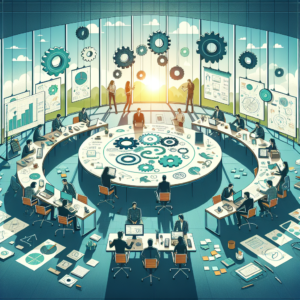Agile-Waterfall Hybrid: Finding the Sweet Spot
In the ever-evolving world of project management, choosing the right methodology can feel like picking the perfect pair of shoes. You want something that fits well, looks good, and gets you where you need to go. Enter the Agile-Waterfall Hybrid—an approach that combines the best of both worlds. But how does it work, and is it the right fit for your team? Let’s dive in! 🏊♂️
Table of Contents
1. Introduction to Agile and Waterfall
2. What is the Agile-Waterfall Hybrid?
3. Benefits of the Hybrid Approach
4. Implementing the Hybrid Model
5. Conclusion
6. FAQs
Introduction to Agile and Waterfall
Before we explore the hybrid model, let’s take a quick detour to understand the two methodologies it combines.
Agile: Known for its flexibility, Agile is iterative and incremental. Teams work in sprints, allowing for continuous feedback and adaptation. Think of it as a dynamic dance routine that evolves with each rehearsal. 💃
Waterfall: This is the traditional, linear approach. Like a river flowing downstream, it follows a set sequence: requirements, design, implementation, verification, and maintenance. It’s the structured waltz of project management. 🎵
What is the Agile-Waterfall Hybrid?
The Agile-Waterfall Hybrid is a project management approach that blends the structured stages of Waterfall with the adaptability of Agile. Imagine having a map (Waterfall) but also the freedom to take detours (Agile) when necessary. It’s about finding a balance that suits the project’s needs.
Benefits of the Hybrid Approach
The hybrid model offers several advantages that make it attractive to diverse teams and projects:
Flexibility with Structure: Teams can enjoy the structured phases of Waterfall while still benefiting from Agile’s flexibility to adapt and iterate. It’s like having a well-planned itinerary with room for spontaneous adventures. 🗺️
Improved Risk Management: With both approaches, teams can better anticipate and mitigate risks. Waterfall’s detailed planning pairs well with Agile’s quick pivots, ensuring fewer surprises. 🎯
Enhanced Collaboration: The hybrid model encourages communication and teamwork, blending Agile’s collaborative spirit with Waterfall’s clear roles and responsibilities. 🤝
Implementing the Hybrid Model
Ready to give the Agile-Waterfall Hybrid a shot? Here’s how to start:
Assess Your Project Needs: Analyze the project’s complexity, timeline, and stakeholder expectations to determine the right balance of Agile and Waterfall elements. 🧐
Customize Your Approach: Define which phases will follow Waterfall and where Agile iterations will be beneficial. Remember, it’s not a one-size-fits-all solution. Tailor it to your team’s strengths and project requirements. 🎨
Continuous Feedback: Keep open lines of communication with all stakeholders. Regular check-ins and feedback loops are crucial in refining the process and ensuring alignment. 📬
Conclusion
The Agile-Waterfall Hybrid offers the best of both worlds, making it an attractive option for projects that require both structure and flexibility. By leveraging the strengths of each methodology, teams can optimize their workflow, manage risks better, and ultimately deliver successful projects. So, are you ready to find your sweet spot? 🍬
FAQs
1. Is the Agile-Waterfall Hybrid suitable for all projects?
Not necessarily. It’s best suited for projects that require both structured phases and flexibility. Assess your project needs before choosing this approach.
2. How can I convince my team to adopt the Agile-Waterfall Hybrid?
Highlight the benefits, such as improved risk management and enhanced collaboration. Share success stories of other teams that have benefited from this approach.
3. What tools can help in implementing the hybrid model?
Tools like Jira, Trello, and Asana can support both Agile and Waterfall processes, making it easier to manage hybrid projects.
4. How do I know if the hybrid approach is working?
Regular feedback from your team and stakeholders will be your best indicators. Monitor project milestones, timelines, and overall satisfaction to gauge success.












